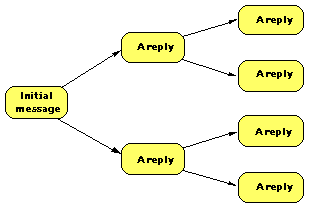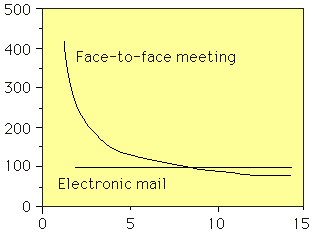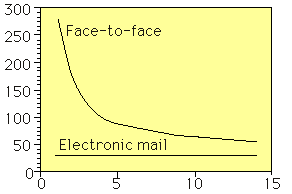| |

Figure 1: Chain reaction of group discussions in electronic
mail
Electronic mail commonly uses either distribution lists or forum systems (also known as computer
conferencing systems or as bulletin board systems for group communication). The lower size
limit for a successful group for the exchange of experience is usually between 20
and 50 active participants. (Groups for other tasks than experience exchange can
be successful with much smaller group sizes.) This is probably because the activity
in these groups is a kind of chain reaction. Much of what is written is a response
to a previous message. Assume, hypothetically, that the probability for each group
participant to reply to a message is 0.05. With N participants in the group, each message
will on average generate 0.05 x (N-1) new messages. If the group size is
21 participants, then this figure will make 1. Thus, with fewer than 21 participants
in the group, on average, each message will generate less than 1 new message, so
that the chain reaction is subcritical. If the group size is larger than 21 participants,
each message will, on average, generate more than one message, and we get a sustained
chain reaction. Of course, the real figures are not always exactly 0.05 and 21, but
the principle still applies: group size must be above a certain threshold if activity
within the group is to be sustained.
Figure 1 shows how a chain reaction of messages can arise if each
message on average causes more than one replying message.
|
|
| |
Much of the communication in electronic
mail systems is group communication. Most electronic mail systems have some built-in
support for group communication ranging from simple distribution lists to advanced
computer conferencing systems. Even in those systems that do not support group communication,
there is almost always a command to write a reply to a multirecipient message, such
that the reply is sent to all recipients of the previous message. Thus you do not
need to input the names of all the recipients again. This means that the previous
message is in fact used as a kind of implicit distribution list. Even this simple
aid supports and is often used for group communication.
Electronic mail is used so often for group communication because
it is particularly efficient for many types of group communication; this will be
explained further below.
Group communication using electronic mail is very different from
ordinary meetings. Even audio and video conferencing and group phone calls are more
similar to face-to-face meetings than to electronic mail. The important difference
is that, in ordinary meetings, all communication is concentrated to a short time
period (usually one or two hours). All communication must be done in this short period,
or it will have to wait for the next scheduled meeting, which might be a week or
a month later. If you forget one aspect of an issue, have to look up a fact, or get
an idea the next day, then it has to wait until the next meeting. With electronic
mail, the process is not concentrated in a fixed meeting period. Participants enter
the system when they have time, read what others have written, give their own views,
and connect again at a later time.
Electronic mail is more efficient for some kinds of group communication
for the following reasons
- You save the cost and effort
of travelling and gathering everyone in the same place at the same time.
- Each participant has greater
control over his own communication: what to read, when to read it, what to read carefully,
what to skip, and when to write his own comments. If you prefer, you can think about
an issue and reply the next day.
- Since you write slower but read
faster than listening and talking in voice communication, written communication is
more efficient if the size of the group is larger than about five people.
 |
Typing:
3.6 minutes
Reading:
11 x 0.47
= 5.2 minutes
Total time:
8.8 minutes |
|
 |
Speaking and
listening:
12 x 1.2
= 14.4 minutes |
| Electronic meeting |
Face-to-face meeting |
Figure 2 Comparison
of the time spent giving and receiving information in written versus spoken communication
in a group with 12 participants.
This last point is very important, and is illustrated by the example in figure 2,
which compares a meeting of twelve people with the same amount of communication via
electronic mail. The figure shows the total spent effort for all the participants
of the group to transfer the information given in an average message. As is shown
in the figure, much less time is needed for the same communication with electronic
mail, if the group size is larger than five participants.
The shorter reading time with electronic mail is caused not only
by the fact that you actually read faster than you listen, but also because you get
more control over your own reading more than over your listening: it is easier to
spend less time on less-important texts and to read carefully what is most important
to you.
The results described above are not only a matter of efficient
use of time, they are also important psychologically. Everyone knows that it is difficult
for face-to-face meetings to work well if the number of participants is larger than
about 5 to 8 people. Typical problems of meetings with many participants are:
- The meeting takes more time than
planned;
- Everyone does not have time to
say what they want;
- There is not enough time to cover
all items on the agenda as fully as needed; and
- Many people feel that too much
of their time is spent in meetings, and within these meetings on discussion of issues
they already know or are not interested in.
There are psychological advantages
to face-to-face meetings too, especially for certain kinds of issues.
This result can also be understood by looking at Figure 2, and
comparing the additional cost of including one more person in the communication process
with electronic mail. This additional cost is less than half of the corresponding
cost at a face-to-face meeting. Thus, with electronic mail, you can choose to include
more people, at more reasonable additional cost than with face-to-face meetings.
Figure 2 only covers the time the participants actually participate
in the meeting. Other costs (gathering everyone at the same time and place, travel,
computer, etc.) are usually higher for face-to-face meetings than for electronic
mail. The technical costs for simultaneous audio conferences are comparable to those
of electronic mail, while video conferences are much more expensive.
Note, however, that the travel cost per meeting minute is smaller
the longer a meeting lasts, for face-to-face meetings. As an example, I have estimated
the cost of a meeting assuming that two-thirds of the participants do not have to
travel and that one-third must travel 150 kilometres. The estimate includes working
time, computer time and travel costs. If more or fewer people have to travel, if
the travel distances are larger or smaller, or if you use other prices, the result
will differ. The result, with given assumptions, are shown in Figure 3.
| Cost in dollars per meeting hour, 1995 dollar values |

Duration of the meeting in hours
|
Figure 3 Comparison of cost for e-mail versus face-to-face
meeting with five participants.
Figure 3 shows that a face-to-face meeting will cost more than
electronic mail if the duration of the meeting is less than a whole day. This is,
of course, the reason why face-to-face meetings where participants have to travel
usually are held at large time intervals, and last for a longer time. It is obviously
a disadvantage if you can only meet a few times a year. With electronic mail, an
issue that needs 15 or 30 minutes of discussion can be taken up immediately, and
there is no need to wait for the next scheduled meeting.
| Cost in dollars per meeting hour, 1995 dollar values |

Duration of the meeting in hours
|
Figure 4: Comparison of cost for e-mail versus face-to-face
meeting with twelve participants.
Figure 4 shows that, with twelve participants, electronic mail
will be less expensive even if the duration of the meeting is two full days.
| Cost in dollars per meeting hour, 1995 dollar values |

Duration of the meeting in hours
|
Figure 5: Comparison of cost for e-mail versus face-to-face
meeting with 33 participants.
Figure 5 shows that, with 33 participants, face-to-face meetings
will be so expensive that such meetings in fact are very seldom organized. Symposia,
lectures, conferences, etc., are of course exceptions. My assumptions are not valid
for such meetings, however, since I have assumed that all participants have roughly
equal rights to speak. At symposia and lectures, this rule does not hold: the speakers
have more opportunities to talk than the other participants. In this way, higher
efficiency is achieved for larger group sizes. This is an important difference between
electronic mail and face-to-face meetings: discussion with equal rights to "talk"
is possible through CMC even with 33 or more participants.
Some may object that this is irrelevant, since large face-to-face
meetings with equal speaking rights are seldom held, but the reason such meetings
are so seldom held is that before electronic mail, there was no efficient medium
for them. If electronic mail provides an efficient medium for large meetings, the
result will be opportunities that simply could not be realised otherwise. The more
people can participate in a discussion, the more people can be kept informed, the
more people get a chance to have their say, the less is the risk of forgetting some
important factor. A survey of users of an e-mail and computer conference system showed
that a large majority of its users agreed with these statements [3].
An interesting factor to note is that, in a face-to-face meeting
with 5 participants, each participant is allowed to talk for an average of 20 percent
of the time. In an electronic mail meeting with 33 participants, each participant
also spends 20 percent of the time giving information, writing messages, etc. See
Figure 6.
| Electronic mail discussion with 33
participants |
Face-to-face meeting with five participants |
 |
Typing:
3.6 minutes
Reading:
32 x 0.47
= 15 minutes
Total time:
18.6 minutes
Typing for
3.6 of 18.6
minutes = 20 % |
 |
Speaking:
1.2 minutes
Listening:
4 x 1.2
= 4.8 minutes
Total time:
6.0 minutes
Speaking for
1.2 of 6.0
minutes = 20 % |
| Figure 6: Number of participants
to get roughly 20 percent giving and 80 percent receiving per participant. |
Maybe human communication (with equal
speaker rights) works best psychologically if the participants can be active and
give information at least 20 percent of the time. This could be the reason why face-to-face
meetings seem to be most efficient with group sizes of about 3-7 people, while group
communication using electronic mail or computer conferencing systems seems to be
efficient in groups of 20-100 people or more.
References
The ideas about group size effects
in this paper were first presented in the book The Network Nation: Human Communication
Via Computer [Hiltz-Turoff 1978].
I first presented the ideas in [Palme 1981].
| Hiltz-Turoff 1978 | The Network Nation, Addison-Wesley 1978, republished by MIT press in 1993.
| | Palme 1981 |
Experience with the use of the COM computerized conferencing system,
FOA Report C 10166.
| | Palme 1995 | Electronic Mail, published by Artech House 1995.
|
|
|



